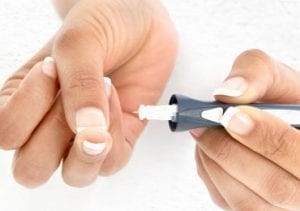If you or somebody from your family or relatives is suffering from Diabetes, then this Diet Plan for Diabetic Patients will be really helpful for you. Couple it with regular exercises and positive lifestyle changes and you can keep your diabetes under control. Afterall it is very important to consume a balanced and planned diet during diabetes. Before we jump on to actual diet let’s take a look at what diabetes is and what are its symptoms and types.
Diabetes is a metabolic disorder in which body is unable to convert sugar into energy. Normally whatever food we eat get converted into glucose during digestion. The hormone insulin which is secreted from Pancreas helps glucose to get into the cell for utilization of energy. Sometimes the insulin is not made by the body and the glucose gets remain in the blood and does not get utilized by the cells. The rise of glucose level in blood is known as Diabetes.
General Symptoms Of Diabetes
1. Hyperglycemia
It is a condition in which blood glucose level is too high.
- Normal fasting blood sugar level -100mg/dl
- Pre-diabetic– 100-125mg/dl
- Diabetes-higher than 126mg/dl
2. Glycosuria
It is a condition in which there is a presence of glucose in the urine. In this condition the blood glucose level is about 180mg/dl.
3. Polyuria
The increase in volume of urine is known as polyuria.
4. Polydipsia
Due to excessive urination there is loss of water and electrolytes which leads to excessive thirst.
5. Feeling of Weakness
As insulin is not properly functioning, the cells gets deprived of energy. In this condition the body feels weak and tired.
6. Blurred Vision
High blood sugar in diabetes affects the lens inside the eyes to swell which causes blurred vision. It is a symptom of diabetes which does not cause any retinal damage. As the blood sugar level goes down the vision starts getting normal.
7. Weight Gain
Weight gain is very common side effect when a person starts taking insulin therapy. It is very important for a diabetic person to keep his/her calories in control. Planning of every meal with right amount of nutrients is necessary in achieving the goal.
8. Diabetic Wound Are Slow To Heal
The elevated blood sugar level causes infection which can be serious and require emergency medical assistance. It has been observed that the wound on the feet are not early noticed in Diabetes and can cause complications later on.
Types of Diabetes Mellitus
Type 1 Diabetes
It is an autoimmune condition in which body’s own immune system attacks the cell of pancreas from which insulin is released. Due to destruction of cells pancreas is not able to make insulin. It is also called Juvenile onset diabetes.
Type 2 Diabetes
It commonly affects 85% to 90% of diabetic people. The insulin produced is not enough to control blood sugar level. The treatment of type 2 diabetes is done with modification in diet and physical activity.
Gestational Diabetes
This type of diabetes may occur in pregnancy. The hormone is formed by placenta during pregnancy which increases the level of glucose. The pancreas releases enough insulin to handle the raised glucose level but if it does not happens then the glucose level enters into the blood and it causes gestational diabetes.
Some Guidelines of Healthy Eating for Diabetic Patients
- Try to have variety of vegetables in your diet. Add all the colorful vegetables especially orange (carrot), red (tomatoes) and yellow (bell pepper).
- Cut down your carbohydrate amount to minimum. Introduce multigrain bread and whole wheat flour in your diet.
- Stop taking refined flour and refined products like biscuits, puff and white bread sandwich.
- Mix gram flour and soy flour in your regular wheat flour to increase fiber content.
- Start taking 3 to 4 serving of fruit per day in your diet. Fruit contains good amount of fiber that gives the feeling of satiety.
- Have 10 to 12 glasses of water including lemon water, vegetable juice, and coconut water. Avoid packed processed fruit juices which contains extra amount of sugar in it.
- Choose low fat milk and skim milk products instead of heavy cream milk.
- Try to use unsaturated fatty acids(MUFA) instead of saturated fatty acids.
- Reduce sugar and salt to minimum amount. The daily recommended amount of salt should not be more than 1500mg.
- Have lots of salad and soup or buttermilk before starting your main meal.
- Try to choose healthy cooking technique like Broiling, Boiling, Roasting and Grilling instead of Frying.
- Do not sleep soon after dinner as sleep slows down the body’s metabolism and accumulate fat. Have an early dinner and keep 2-3 hours gap before going to bed.
- Half the plate should be filled with green vegetable, one fourth should be grain and starchy vegetable and other quarter should be legumes, meat or egg.
- The amount of food you consume is related to the level of blood glucose. If you eat more than the recommended amount, the glucose level will rise so it is very important for a diabetic person to check their calories. It is advised to take small frequent meals to avoid sugar loading.
- Free foods are certain foods which can be introduced in your diet apart than your diet plan but the calorie count should not be more than 20 calorie. Some examples of free food are:
- Tea or coffee
- Carbonated water
- Broth
- Soup
Important : This should be kept in mind that free food should only be added 1 serving once in a day.
Role Of Nutrients In Managing Diabetes
Carbohydrates : When we first hear the word diabetes, it is clear in our mind that no more sweets and carbohydrates to be consumed. But with the help in changing lifestyle and advice of doctor and nutritionist we can be successful in managing diabetes.
Carbohydrates play major role in regulating our blood sugar level. It has been advised that a diabetic person should not keep long gap in between meals but it is also important that one should not go for simple sugars including fructose and glucose. Always try to have complex carbohydrates rather than simple carbs. The carbohydrate that contains simple sugars (like refined flour) are easily absorbed and cause the blood sugar level to rise very quickly but in complex carbs (whole grain) are broken down slowly which does not allow the blood sugar level to rise so fast.
Glycemic index is also very important factor which affect blood glucose level to rise. Foods with high glycemic index must be avoid from the diet of diabetic individuals.
Glycemic Index of certain foods are less than 60%.
| Food | Glycemic index |
| Peas | 51 |
| Rajma | 29 |
| Lentils | 29 |
| Apples | 39 |
| Orange | 40 |
| Methi | 34 |
| Curd | 36 |
| Barley | 31 |
| Oats | 49 |
| Corn | 51 |
Proteins – People who are on high protein diet consume protein sources like soy, eggs, chicken, and fish. A normal body needs 1 gram protein per kilogram of body weight but it is also very important to notice that excess protein consumed gets converted into glucose and stored as glycogen in liver.
- High protein and low carbohydrate suppress the appetite by producing ketones.
- Protein gives satiety feeling by making you feel full for a longer time.
- High protein also helps in weight loss by reducing the amount of carbohydrate.
- High protein cannot be given to people who has diabetic nephropathy because high protein puts too much load on kidneys.
Foods Which Show Good Results In Reducing Blood Glucose Level
1. Green Leafy Vegetables
Green leafy vegetables are low in calories and high in vitamin C content which helps to reduce blood glucose level in Type 2 diabetes. They are also good in antioxidants like Lutein and Zeaxanthin which protects from cataract which is a common complication in diabetes.
2. Fenugreek Seeds
They are rich in antioxidants, vitamins and minerals which help our body from free radicals. It has good amount of soluble fiber in it which helps to slow down the absorption process which results in reducing blood sugar level.
3. Apple Cider Vinegar
Taking diluted (10ml in 20ml of water) apple cider vinegar helps in reducing blood sugar level after meals.
4. Garlic
It has been observed that eating raw garlic is very beneficial as garlic contain Allicin which increases the insulin activity.
5. Citrus Fruits
Fruits like oranges, sweet lime and lemon contains good amount of vitamin C and antioxidants. Some berries like strawberry, raspberry and blueberry have low GI (Glycemic Index). Fruits contain natural sugar (fructose) in them, so it is very important to select those fruits which has Glycemic Index less than 55.
Diet Plan For A Diabetic Patient
Age – 45 years
Gender – Male
Height – 5 feet 6 inches
Physical activity – Sedentary
Food habits – Non Vegetarian
Present weight – 75kg
Recommended Dietary Allowance
Estimate IBW(Ideal Body Weight) –
50kg + 2.3 per inch over 5 feet
IBW=64 kg
Energy required for a normal weight
64 x 30 = 1920 kcal
Excess weight above IBW
75 – 64 = 11 kg
Energy required to maintain present weight
1920 + 8.8 x 11 = 2016.8
Energy required to lose weight
2016.8 – 500 = 1516.8 kcal approx.
Menu Plan For A Diabetic Diet Chart
Time : 6:30 AM
1 glass of warm water with half tea spoon of flax seeds
Time : 7:00 AM
1 cup tea(without sugar) and 2 Marie biscuits
Breakfast : 8:30 AM
- Half cup milk (without sugar)
- 1 Boiled Egg
- 1 bowl vegetable oats upma
- 1 orange
Mid-Morning : 10 AM
- Lemon water
- 1 Apple
Lunch : 1 PM
- Spinach with dal
- Beans vegetable
- 2 Multigrain Roti
- Vegetable Raita
- Cucumber salad
- Buttermilk
Evening : 4:30 PM
Half bowl roasted grams
Late evening : 6 PM
1 cup green tea
Dinner : 8:30 PM
- 1 Bowl Vegetable Lauki curry
- Sprout salad
- 1 Bowl Washed moong dal
- 2 Missi roti
Post Dinner : 9:30 PM
- Half cup milk (without sugar)
- Total calories 1531
- Carbohydrate 214 grams (approx.)
- Protein 61.2 grams
- Fat 51 grams
Meanwhile you may also want to learn how turmeric can be used to keep diabetes under control.
A Diabetic diet is more about following healthy food habits. The diet should not be so complicated to accept. It is not about to give up all your favorite delicacies. Try to plan your meal smartly, track your food record by maintaining a food diary and upgrade your knowledge about different ingredients and hidden sugar in your food item. Try to make healthy choices and monitor your sugar level regularly. Indulge yourself in any physical activity that you like most like cycling, dancing, aerobics or swimming.
I hope this article will help you a lot in managing your diabetes and to maintain a healthy life. If you liked this article then please share it with your friends on social media. Also please leave your thoughts in the comments section below.
Thanks!
Read Next – 7 Diabetes Friendly Foods That You Must Be Aware Of!


















